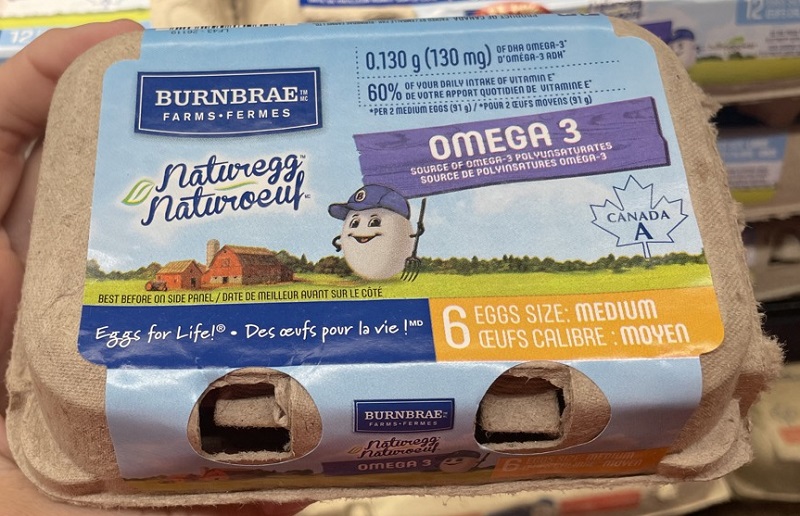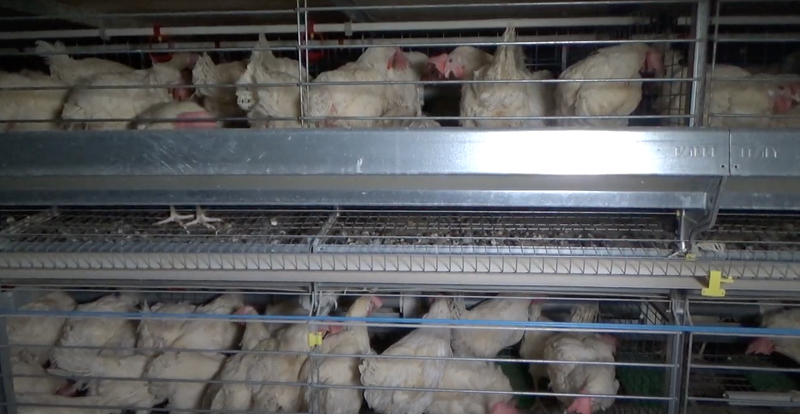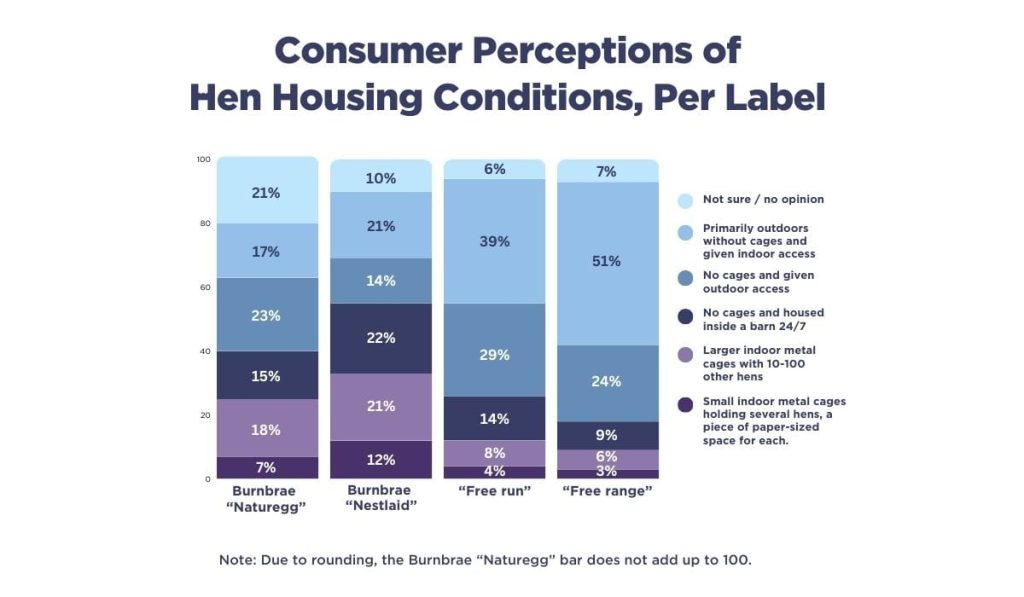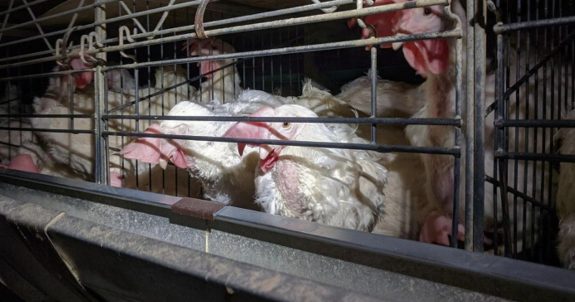A survey of more than 1,000 Canadian residents found that egg packaging from multiple companies is highly misleading, with consumers wrongly believing hens live in better conditions than they truly do, leading to misinformed—and costly—egg purchasing decisions. The report was conducted by Bryant Research and commissioned by Animal Justice.
Notably, of the 95 percent of respondents who purchase eggs, 54 percent reported that animal welfare influences the eggs they buy, and only 7 percent feel that the accuracy of welfare labels on egg packaging is unimportant. The vast majority of consumers reported that they have deliberately spent more on specific egg brands, under the belief that those hens experienced higher welfare.
Housing Conditions
Participants were shown photos of common egg packaging and asked what type of housing they believed the egg-laying hens experienced.
When shown Burnbrae’s “Naturegg” packaging:
- Only 7 percent of consumers correctly answered that these hens are held in small indoor metal cages, each hen afforded only the space equivalent to a sheet of paper. These are called “battery cages” or “conventional housing” by the industry.
- 73 percent of consumers assumed these hens experience some degree of better housing conditions.
Just over 50 percent of Canadian hens are housed under this system.
Example of Burnbrae’s “Naturegg” packaging vs typical housing conditions.


When shown Burnbrae’s “Nestlaid” brand of eggs:
- Only 21 percent of consumers correctly answered that these hens are held in larger indoor metal cages, with 10-100 hens per cage.
- 57 percent of respondents incorrectly believed that these hens were housed in better, cageless conditions.
- When shown an additional image of an egg carton claiming “enriched colony” housing used for Burnbrae Nestlaid eggs, only 11 percent correctly answered that this term refers to metal cages.
The Canadian egg industry has barely budged away from cages. Instead, it’s moving toward what it calls “enriched” battery cages, which are just slightly larger cages. As of 2022, 31.58 percent of hens in Canada are in enriched battery cages, also called “enriched colonies”.
Example of Burnbrae’s “Nestlaid” (“enriched cages”) packaging vs typical housing conditions.



When shown various “free run” eggs examples:
- Only 14 percent of consumers correctly answered that these hens are held indoors, cageless, 24/7.
- 68 percent of consumers believed these hens are housed in better conditions with outdoor space.
- Several countries and states banning caged egg production are moving towards cage-free, “free run”, systems, which provide some welfare improvement. Unfortunately, only 10.84 percent of Canadian hens are in “free run” systems.
Example of “free-run” packaging vs typical housing conditions.


When shown various “free range” packaging examples:
- Only 24 percent of consumers correctly answered that these hens are housed in an indoor cageless system and granted outdoor access.
- 51 percent believed these hens experience better housing conditions—being housed primarily outdoors with indoor access.
- On paper, “free range” hens are supposed to have outdoor access, but this is weather-dependent and entirely at the farmer’s discretion—not subject to any inspections or enforcement. In reality, this means many free range hens in Canada rarely go outside.
- Free range systems, also used for organic eggs, provide more opportunities for hens to engage in natural behaviours and are considered higher welfare systems. In Canada, only 6.42 percent of hens are housed in free range or organic systems.

Nestlaid Eggs Highly Misleading
Consumers reported misconceptions regarding Burnbrae’s Nestlaid egg label, a caged housing system offering some minimal environmental enhancements to larger battery cages.
- Only 13 percent of respondents correctly answered that the nests provided in “Nestlaid” systems are merely a wire floor surrounded by hanging plastic flaps.
- 80 percent of consumers believed that these hens had access to natural light.
- 74 percent of consumers believed that these hens had access to outdoor space.
- 76 percent of consumers believed that these hens could move about freely.
- 67 percent of consumers believed that these hens could walk on comfortable surfaces rather than metal cage wires.
- 62 percent of consumers believed that these hens were not subject to beak trimming.
None of these assumptions are accurate.
Example of the nests provided in the “Nestlaid” system.

Additionally, while “free run” and “free range” labels offer improvements compared to caged systems, consumers overestimate the quality of life these systems offer.
- “Free run” hens are not kept in cages, but there is no requirement for them to have outdoor access or natural light. However, 84 percent of consumers believed that these hens have access to natural light, and 83 percent believed that these hens have access to the outdoors.
- 51 percent of respondents believe that “free range” hens are housed primarily outdoors with indoor access, and 79 percent believe that they are not subject to beak trimming—neither of which are correct.

Truth in Egg Labelling Should Be a Priority
Canadian consumers are willing to pay more for eggs that come from hens they believe are treated better, but they can’t make better choices if labels are deliberately misleading.
Currently, Canada does not regulate any claims made by egg companies on packaging and labels—and there are no legal definitions of terms like “free range” or “enriched colony housing”. Federal authorities have given these concerns a low priority, allowing “humane-washing” by brands looking to add perceived value to their products.
Findings from a previous Bryant Research study emphasized a strong consumer demand among Canadian consumers for transparency in egg sourcing and animal welfare claims. Retailers that provide clear signage on egg types have seen results. Save-On-Foods became the first retailer in North America to introduce signage that clearly distinguishes between battery cage and cage-free eggs. As a result, they saw a shift in cage-free sales, now accounting for over 43 percent of total egg sales. In contrast, Loblaws, the largest Canadian retailer, reports only 17 percent of total egg sales are cage-free—even though 79 percent of their consumers support a ban on caged eggs and 74 percent want in-store signage depicting animal welfare commitments.
It’s time to put an end to misleading marketing by the Canadian egg industry. Join our mailing list to stay up to date on upcoming campaigns to protect hens!




